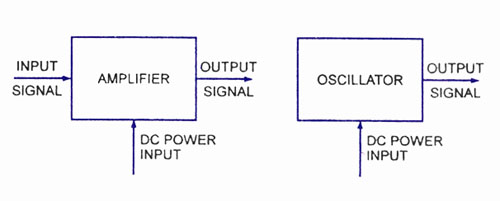Introduction to Oscillators
An oscillator is the basic element of all ac signal sources. It generates a sinusoidal signal of known frequency and amplitude. An oscillator is one of the most basic and useful instruments used in electrical and electronic measurements.
Since sinusoidal waveforms are encountered so frequently in electronic measurement work, the oscillator (sine wave generator) represents the largest single category of signal generators. This device covers the frequency range from a few Hz to many GHz.
Although an oscillator is known as a sinusoidal signal “generating” device, it is to be noted that it does not create energy, but merely acts as an energy converter. All it does is convert the unidirectional current drawn from a dc source of supply into an alternating current of desired frequency. The idea is the reverse process of what happens in a rectifier and, therefore, can also be called as an inverter. However, we generally think of oscillator circuits as providing an ac voltage signal.
Applications
- An oscillator is mostly used in electronic communication equipments.
- “Local” oscillators are used to assist the reduction of the incoming radio frequency (RF) to a lower intermediate frequency in different modulations like AM (amplitude modulation) and FM (frequency modulation) super heterodyne receivers.
- Oscillator circuits are also used to generate the RF carrier in the “exciter” section of a transmitter.
- They are also used as “clocks” in digital systems such as microcomputers, in the sweep circuits found in TV sets and oscilloscopes.
An alternator cannot be called as an oscillator although it can generate sinusoidal ac power of 50 Hz. An oscillator is a non-rotating electronic device that converts dc energy into ac energy of frequency ranging from a few Hz to many GHz. But, an alternator is a mechanical device that have rotating parts, converts mechanical energy into ac energy and that cannot produce ac energy of high frequency.
Though an oscillator generates a large amount of ac power, it is preferred for several applications such as radio-transmitters and receivers, radars and so on. Take a look at the advantages given below.
Advantages
(i) Portable and cheap in cost.
(ii) An oscillator is a non-rotating device. Consequently, there is no wear and tear and hence longer life.
(iii) Frequency of oscillation may be conveniently varied.
(iv) Voltage or currents of any frequency (20 Hz to 100 MHz) adjustable over a wide range can be generated.
(v) Frequency once set remains constant for a considerable period of time.
(vi) Voltages free from harmonics as well as rich with harmonics can be generated by sinusoidal oscillators and relaxation oscillators respectively.
(vii) Operation of an oscillator is silent, as there is no moving part in it.
(viii) High operation efficiency—due to absence of moving part, there is no wastage of energy owing to friction.
For having a sinusoidal oscillator, we require an amplifier with positive feedback. The idea is to use the feedback signal in place of an input signal. If the loop gain and phase are correct, there will be an output signal even though there is no external input signal. In other words, an oscillator is an amplifier that is modified by positive feedback to supply its own input signal.
The difference between an amplifier and an oscillator:
The difference between an amplifier and an oscillator is explained with the help of figure given above.
An amplifier strengthens the input signal without any change in its waveform and frequency. The additional power required comes from the external dc source. Thus an amplifier can be called as an energy converter that draws energy from a dc supply and converts it into ac energy at signal frequency, the energy conversion process being controlled by the input signal. The main difference with an oscillator is that an oscillator does not need any external signal either to start or maintain the process of energy conversion. Apart from this, the energy conversion process is controlled by the oscillator circuit itself, as shown in the figure given above. In an oscillator, the passive components that are used for the circuit decides the output signal frequency. In order to bring a change in the output signal a change in the passive components is enough. Oscillator may provide fixed or variable frequency.
If an oscillator is used an instrument, it may be called with different names such as test oscillator (or signal generator), standard signal generator (or function generator) and so on. The name depends on the function performed by the device, type of signal produced by it, order of sophistication and so on.
There are mainly two categories of oscillators – harmonic oscillators and relaxation oscillators. Both types can include active devices such as BJTs, FETs and op-amps, and passive components such as resistors, capacitors and inductors. In harmonic oscillators, the energy always flows in one direction-from the active to passive components. However, in relaxation oscillators, the energy is exchanged between the active and passive components. In harmonic oscillators, the frequency of oscillations is determined by the feedback path. However, in relaxation oscillators, the frequency is determined by time constants specifically, the charge and discharge time constants during the exchange of energy. Harmonic oscillators can be used to generate low-distortion sinusoidal output waveforms, but relaxation oscillators can only generate non-sinusoidal waveforms such as sawtooth, square or triangular.
We have more related and advanced articles about Oscillators. Please take a look.
FREQUENCY STABILITY OF OSCILLATORS


Comments are closed.